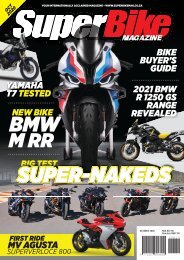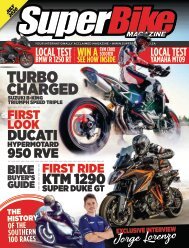SuperBike Magazine September 2020
Loads of content to keep any motorcycle enthusiast entertained!
Loads of content to keep any motorcycle enthusiast entertained!
Create successful ePaper yourself
Turn your PDF publications into a flip-book with our unique Google optimized e-Paper software.
70 <strong>SuperBike</strong><br />
sets of two carburettors and they stayed<br />
on the 250 for most of the year.”<br />
Shenton enjoyed working with<br />
Spencer, the clean-living youngster who<br />
stood out like a nun in a lap-dancing<br />
club during an era of wild, hard-drinking<br />
racers.<br />
“Freddie had a very different outlook<br />
on life from your average motorbike racer,<br />
maybe it was because of where he<br />
came from. He was a brilliant rider, but<br />
he wouldn’t really say what was going<br />
on with the bike. Perhaps it was because<br />
he hadn’t had a lot of time to mature<br />
and learn. He’d say stuff like there’s<br />
something going on with the back, so<br />
you’d ask him is it the tyre or is it the<br />
shock? And he’d just say there’s something<br />
wrong with the back. He was one<br />
of those guys who would ride the wheels<br />
off the thing on the day.<br />
“He was a bit of an enigma to work<br />
with. There was no social interaction,<br />
but he was always polite and well-spoken<br />
and he was fine. The unfortunate<br />
thing about Freddie was his naivety.<br />
Business-wise he got ripped off horrendously<br />
by all the managers and lawyers<br />
he had doing stuff for him.”<br />
Shenton later worked with Wayne<br />
Gardner during 1987, his title-winning<br />
season, and 1988. Gardner might have<br />
retained the 500 crown if HRC hadn’t<br />
assigned a new engineering group who<br />
got everything wrong.<br />
“The 1988 bike was horrendous. HRC<br />
had talked to Erv about flat trackers<br />
and grip. For some unknown reason<br />
they worked out that most flat trackers<br />
have flat swinging-arm angles, so they<br />
built the ’88 bike with a swingarm pivot<br />
18mm lower than the ’87 bike. When we<br />
got to the first race we realised there<br />
was a quite a serious problem.”<br />
In 1992 Shenton accepted an offer<br />
to join Suzuki, working with Kevin<br />
Schwantz. The Texan won the title the<br />
following year – at his sixth attempt –<br />
and attributes much of that success to<br />
Shenton’s input.<br />
“I inherited quite a low-engineered<br />
bike and we messed our through 1992,”<br />
says Shenton. “I pretty much lived in<br />
Australia the next winter – we were testing<br />
at Eastern Creek every week – and a<br />
good bike came out of that.<br />
“There are two types of riders. There<br />
are the guys who tell you what they’re<br />
feeling and leave it up to you and the<br />
other engineers to interpret that. Then<br />
there are the others who try to engineer<br />
their bike, which in my experience isn’t<br />
Celebrating Wayne Gardner’s 1987 world title. From left:<br />
mechanics Wilf Needham and Shenton, crew chief Jeremy<br />
Burgess and WG’s manager Harris Barnett<br />
always the best way. I guess there’s<br />
a happy medium. Kevin was good,<br />
he was very descriptive and could<br />
pin stuff down.<br />
“We did a test the week before<br />
the Japanese GP, trying out the<br />
latest chassis from the factory and<br />
it was by far the best chassis we’d<br />
had. We were going straight from<br />
Australia to Suzuka and we didn’t<br />
have time to ship the bikes, so I<br />
hand carried the chassis to Japan<br />
with my luggage. I’m near the top of<br />
a 60-metre escalator in Tokyo train<br />
station with the chassis strapped<br />
to my back when the strap breaks.<br />
The chassis flies down the escalator,<br />
wiping out all these Japanese<br />
people on the way down, then lands<br />
with a bloody great clunk at the bottom.<br />
Oh my God, the chassis we’re<br />
going to use for the Suzuka race is<br />
bent!”<br />
But the chassis wasn’t bent and<br />
Schwantz took second in the race,<br />
a fraction behind Yamaha’s Wayne<br />
Rainey, and went on to win the title.<br />
Everyone knows how that season<br />
ended: with Rainey crashing at Misano<br />
and breaking his back. Shenton<br />
and Schwantz still feel guilt for<br />
what happened that day.<br />
“That weekend we were having<br />
problems, we didn’t have a suitable<br />
front tyre. The soft tyre wouldn’t<br />
go the distance and the hard one<br />
wouldn’t give us the grip or the lap<br />
time. So we decided to go with the<br />
soft because we wanted to push<br />
Wayne into a mistake, obviously not<br />
having any idea of the consequences.<br />
It’s something in the back of our<br />
minds with Kevin and me to this day.<br />
We’ve talked to Wayne about it and<br />
he’s very gracious about it. He said,<br />
‘Hey, I would’ve raced Kevin how I<br />
raced him anyway’.”<br />
Shenton enjoyed working with<br />
Schwantz. “Kevin was a fantastic<br />
team player. He’d sweep the floor









